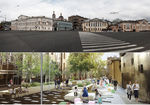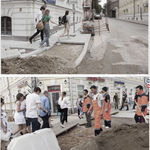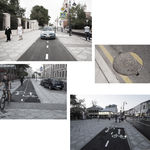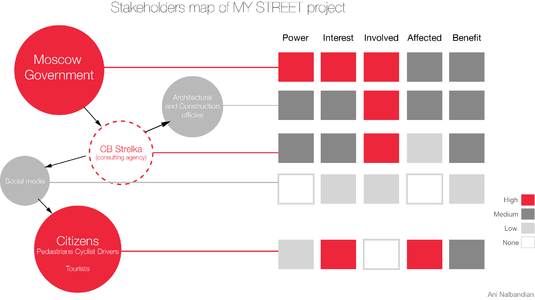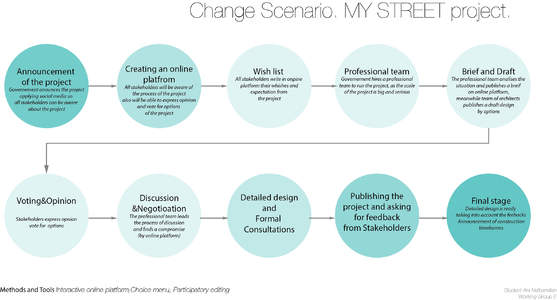Landscape Democracy 2015 Working Group E - Case Study 5: Difference between revisions
No edit summary |
|||
| (23 intermediate revisions by 2 users not shown) | |||
| Line 6: | Line 6: | ||
{| align="right" width="300pt" style="background:Gainsboro; color:black" | {| align="right" width="300pt" style="background:Gainsboro; color:black" | ||
|- | |- | ||
| '''Place name''' ||style="background:Lavender"| '' Central | | '''Place name''' ||style="background:Lavender"| '' Central Moscow'' | ||
|- | |- | ||
| '''Location''' || style="background:Lavender"|''Moscow'' | | '''Location''' || style="background:Lavender"|''Moscow'' | ||
| Line 33: | Line 33: | ||
== Rationale: Why have you chosen this case for the landscape and democracy seminar? == | == Rationale: Why have you chosen this case for the landscape and democracy seminar? == | ||
«My street» project is a big governmental project of Moscow. The aim of the project is to make the city center more comfortable for pedestrians and bring more cyclists to the city what is quite usual for any developing big city. The first phase of the program (2014-2015 years) will focus on creating new pedestrian zones within and outside the central part of town – about 50 kilometers of pedestrian streets and especially areas near the metro and transport interchange nodes. There is also a big target to make the city greener. According to Moscow Government, the project is one of the main directions for the city improvement in the coming years. | |||
However, the project doesn’t involve people’s opinion and creates a lot of problems for pedestrians and car drivers and in fact makes cycle lanes useless because of fast and not accurate design. | |||
== Representation of your observations == | == Representation of your observations == | ||
| Line 40: | Line 41: | ||
* please add any visual material to the gallery, videos can be placed below, you may add text as you like | * please add any visual material to the gallery, videos can be placed below, you may add text as you like | ||
<gallery caption=" | <gallery caption="Observations" widths="150px" heights="150px" perrow="4"> | ||
Image: | Image:Moscow Ani 3.jpg|Real/Target | ||
Image: | Image:Moscow Ani 2.jpg|Case Representation | ||
Image: | Image:Moscow Ani 4.jpg|During construction | ||
Image: | Image:Moscow Ani 1.jpg|Already finished, but with lots of drawbacks | ||
Image:Moscow Ani 5.jpg|weak implimentation of greenery,which caeses impediments for pedastrians | |||
</gallery> | </gallery> | ||
== Reflection == | == Reflection == | ||
=== What are the major challenges for changing the situation? === | === What are the major challenges for changing the situation?=== | ||
The aim in general is very generous as the government wants to change the city and the city becomes more democratic to pedastrians as the | |||
reduction of cars is really visible even on now-stage of the program. However, there also are negative sides: | |||
-The approach is very „bold“ and fast | |||
-The design which is creating for the people does not | |||
involve people‘s opinion and interaction | |||
-A huge budget expenses is spent on expensive materials, | |||
however, there are a lot of social issues that could be solved by this money | |||
-streets are loosing identity and locals loose their usual perception of their home streets | |||
-the project which aimes to make city more for people is not democratic itself. Projects are not available anywhere and people just get what they get. | |||
=== What could be a starting point for democractically-based change? === | === What could be a starting point for democractically-based change? === | ||
The democratic point of "My Street" project could be reached quite easily, in my opinion. People appear quite happy to have this changes, but the design could be much more useful if citizens opinion would been taken into account. It would simply make the project more efficient than it is now. There is already a good example in Moscow of involving people in city's development. The government of Moscow created an application for smartphones called "Good citizen" and every day there is a suggestion about anything what is going to change in the city. People can vote and choose. Unfortunately, the application doesn't cover architectural and urban design projects. But this kind of significant projects as My Street could also be suggested for vote in order to understand, for example, which streets can sacrifice parking spaces to enlarging sidewalks or which streets need cycle lanes separated and safe from cars flow. There would be also good to have projects available to see on websites of Moscow government and to cover them more by social medias. | |||
== Stakeholder Mapping == | |||
''Create a visual representation of the stakeholder groups that are involved in your case. Try to cover the following aspects in your representation: Power (high, medium, low) / Support (positive, neutral, negative)/ Influence (high or low)/ Need (strong, medium, weak)+ also map the relationships between the stakeholder groups'' | |||
<gallery caption="Stakeholder Map" widths="600px" heights="300px" perrow="1"> | |||
File:Stakeholder map Ani.png|Stakeholder Map | |||
</gallery> | |||
== Change Scenario == | |||
''Look at the various methods and tools available and think how they can be applied creatively. Think about the needs of different stakeholder groups - you may need a methodical mix to address them all. Visualize a scenario illustrating how these methods/tools can be applied within an imagined time frame '' | |||
<gallery caption="Change Scenario" widths="600px" heights="300px" perrow="1"> | |||
File:Change Scenario Ani.png|Change Scenario | |||
</gallery> | |||
== Cross cutting theme == | |||
Identify a cross-cutting theme/topic between the cases of your group and write a short reflection on it (approx. 150 words) | |||
' | |||
In spite the fact that all case-studie’s locations are different and the backgrounds are diverse as well there can be made a clear outline that the projects in every case were run without any participation of public. Although the case in Indonesia differs from others, the general problem of our group is the lack or in some projects the absence of involving people in the project’s process. Involving-people point starts from communication between the government and citizens and taking into account the opinion of public. That can cause of course endless negotiation process, but the least what can be done is show the project in social medias and keep people aware about the project. Only some projects of our group case studies were in newspapers and news. | |||
What is common also in projects of case studies is that the projects are run by the government. Moreover, the projects are made for citizens. However, mostly there is no communication or there is a lack of it in every project, there is no participation of public and there is a lack of transparency. | |||
== Concluding reflections == | |||
Reflect on your case and your change model. Potentials? Limitations? (approx. 150 words) | |||
== References == | == References == | ||
| Line 58: | Line 95: | ||
''* Do not use images of which you do not hold the copyright.'' | ''* Do not use images of which you do not hold the copyright.'' | ||
'' | ''http://www.the-village.ru/village/city/picture-story/225407-neglinnaya-ulitsa'' ' | ||
''http://varlamov.ru/1143165.html''' | |||
''http://archspeech.com/article/predmet-diskussii-i-degustacii-obshhestvennye-prostranstva-novoy-formacii''' | |||
"http://expert.ru/expert/2015/42/epidemiya-blagoustrojstva/"' | |||
Latest revision as of 20:53, 9 February 2016
---> back to group page working group E
Please add the title of your case study here, adjust the map coordinates (lat + lng) and replace the moa image with a characteristic image of your site
| Place name | Central Moscow | |
| Location | Moscow | |
| Country | Russian Federation | |
| Author(s) | Governmental project | |
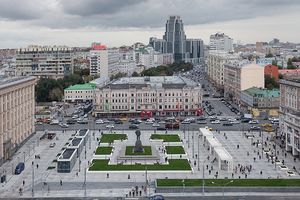
| ||
|
| ||
Rationale: Why have you chosen this case for the landscape and democracy seminar?
«My street» project is a big governmental project of Moscow. The aim of the project is to make the city center more comfortable for pedestrians and bring more cyclists to the city what is quite usual for any developing big city. The first phase of the program (2014-2015 years) will focus on creating new pedestrian zones within and outside the central part of town – about 50 kilometers of pedestrian streets and especially areas near the metro and transport interchange nodes. There is also a big target to make the city greener. According to Moscow Government, the project is one of the main directions for the city improvement in the coming years. However, the project doesn’t involve people’s opinion and creates a lot of problems for pedestrians and car drivers and in fact makes cycle lanes useless because of fast and not accurate design.
Representation of your observations
- you are basically free to use one or a mix of different presentation techniques
- possibilities are: analytical drawings, graphical representations, collages, video clips, comic/graphic novel, written essay/visual essay
- please add any visual material to the gallery, videos can be placed below, you may add text as you like
- Observations
Reflection
What are the major challenges for changing the situation?
The aim in general is very generous as the government wants to change the city and the city becomes more democratic to pedastrians as the reduction of cars is really visible even on now-stage of the program. However, there also are negative sides: -The approach is very „bold“ and fast -The design which is creating for the people does not involve people‘s opinion and interaction -A huge budget expenses is spent on expensive materials, however, there are a lot of social issues that could be solved by this money -streets are loosing identity and locals loose their usual perception of their home streets -the project which aimes to make city more for people is not democratic itself. Projects are not available anywhere and people just get what they get.
What could be a starting point for democractically-based change?
The democratic point of "My Street" project could be reached quite easily, in my opinion. People appear quite happy to have this changes, but the design could be much more useful if citizens opinion would been taken into account. It would simply make the project more efficient than it is now. There is already a good example in Moscow of involving people in city's development. The government of Moscow created an application for smartphones called "Good citizen" and every day there is a suggestion about anything what is going to change in the city. People can vote and choose. Unfortunately, the application doesn't cover architectural and urban design projects. But this kind of significant projects as My Street could also be suggested for vote in order to understand, for example, which streets can sacrifice parking spaces to enlarging sidewalks or which streets need cycle lanes separated and safe from cars flow. There would be also good to have projects available to see on websites of Moscow government and to cover them more by social medias.
Stakeholder Mapping
Create a visual representation of the stakeholder groups that are involved in your case. Try to cover the following aspects in your representation: Power (high, medium, low) / Support (positive, neutral, negative)/ Influence (high or low)/ Need (strong, medium, weak)+ also map the relationships between the stakeholder groups
- Stakeholder Map
Change Scenario
Look at the various methods and tools available and think how they can be applied creatively. Think about the needs of different stakeholder groups - you may need a methodical mix to address them all. Visualize a scenario illustrating how these methods/tools can be applied within an imagined time frame
- Change Scenario
Cross cutting theme
Identify a cross-cutting theme/topic between the cases of your group and write a short reflection on it (approx. 150 words) ' In spite the fact that all case-studie’s locations are different and the backgrounds are diverse as well there can be made a clear outline that the projects in every case were run without any participation of public. Although the case in Indonesia differs from others, the general problem of our group is the lack or in some projects the absence of involving people in the project’s process. Involving-people point starts from communication between the government and citizens and taking into account the opinion of public. That can cause of course endless negotiation process, but the least what can be done is show the project in social medias and keep people aware about the project. Only some projects of our group case studies were in newspapers and news. What is common also in projects of case studies is that the projects are run by the government. Moreover, the projects are made for citizens. However, mostly there is no communication or there is a lack of it in every project, there is no participation of public and there is a lack of transparency.
Concluding reflections
Reflect on your case and your change model. Potentials? Limitations? (approx. 150 words)
References
* Please make sure that you give proper references of all external resources used.
* Do not use images of which you do not hold the copyright.
http://www.the-village.ru/village/city/picture-story/225407-neglinnaya-ulitsa ' http://varlamov.ru/1143165.html' http://archspeech.com/article/predmet-diskussii-i-degustacii-obshhestvennye-prostranstva-novoy-formacii' "http://expert.ru/expert/2015/42/epidemiya-blagoustrojstva/"'
About categories: You can add more categories with this tag: "", add your categories
